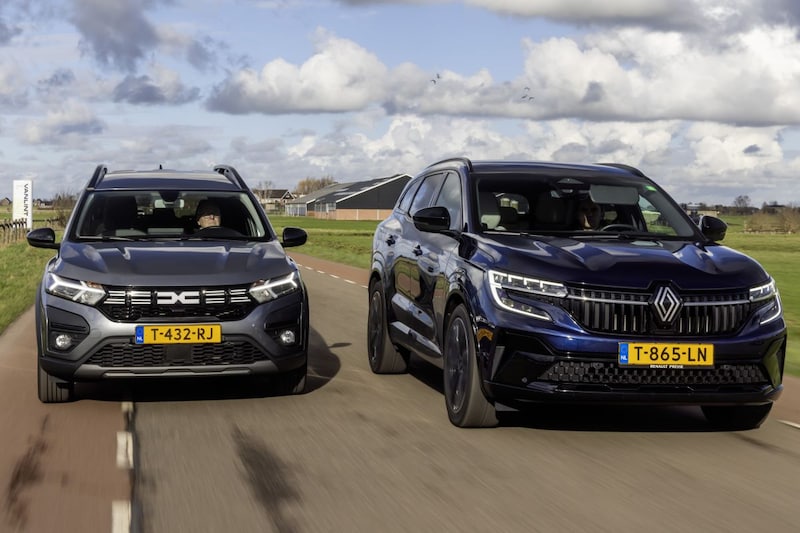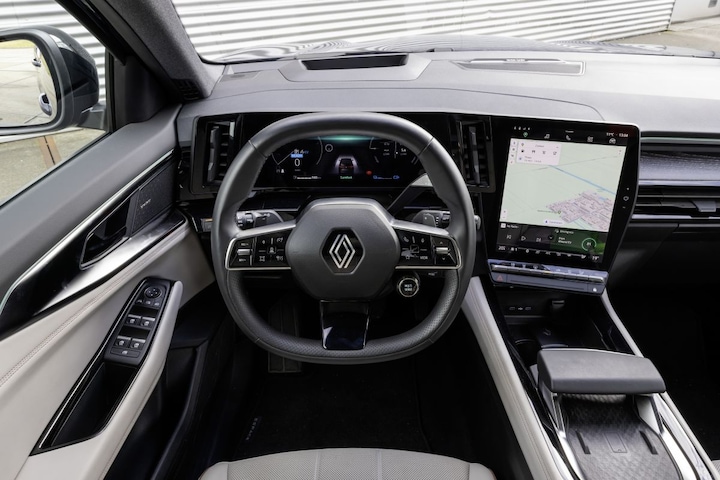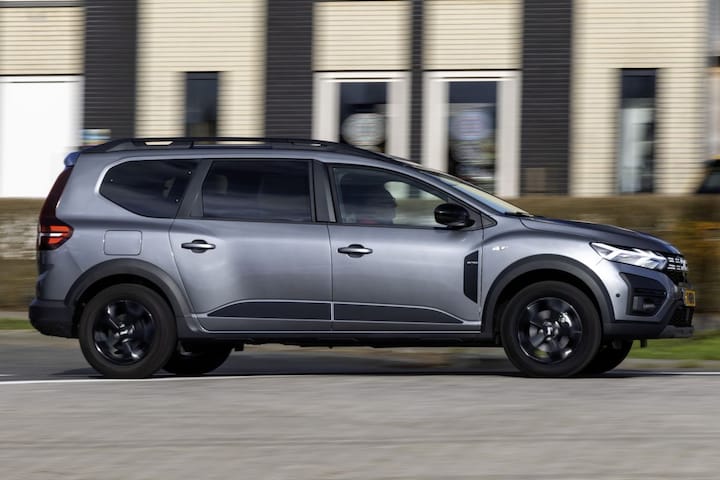And it only costs half…

One times seven is thirty and two times seven is almost sixty. The table of seven normally does not work like this, but in the case of the seven-seater Dacia Jogger and the seven-seater Renault Espace it does. They are two hybrid seven-seaters from the same house and yet the Renault costs almost twice as much. Can that be justified?
Admittedly, for ‘almost twice as much’ we have to do a bit of smuggling. The seven-seater Dacia Jogger is available as a hybrid from €30,250, the Renault Espace – always a hybrid – costs at least €47,490 as a seven-seater. Based on the basic price, the Renault is ‘only’ 57 percent more expensive than the Dacia. However, the tested Espace is a completely loaded Iconic and including all options we are talking about almost 58 grand. Look, then the hybrid Dacia without options suddenly costs a little more than half, or less than half if the Jogger in question does not have to be a hybrid. For the fairest possible comparison, we now opt for the hybrid, which is the only Jogger in which you do not have to switch gears yourself. Dacia is thus tapping into a new buyer group, while the Jogger is already unique by nature. This is due to the low price, but certainly due to its shape. In fact, this is a seriously stretched and raised station wagon based on the Sandero Stepway, a compact hatchback. As if Volkswagen were to develop a seven-seater based on the Polo! Yet the Jogger is certainly not cramped. Its high roof, long wheelbase and vertical rear provide a maximum amount of space and even make the Jogger slightly more spacious than the larger Espace with all benches flat or removed.

In the Dacia Jogger you sit high in the back
Because the Dacia is not a real SUV and has a relatively low floor, the interior as a whole is actually higher. You notice this when stacking large items inwards at the higher opening, but it is also palpable in the interior. For example, the rear seat is noticeably higher than the front seats, while even passengers at the very back still have sufficient headroom and can adopt a fairly natural seating position. Moreover, they can easily look outside through the large side windows and low shoulder line.

The back seat of the Dacia Jogger.

This way you sit all the way in the back of the Renault Espace.

And so on in the middle row of seats.
Claustrophobic in the back of the Espace
In the Espace it is slightly different. Due to the high floor, you sit at the very back with your legs strongly raised, while the top of your head quickly touches the roof. Since in practice mainly children sit here, that may not be so bad. But especially with children it is annoying that the high side windows are small here, so that it quickly becomes claustrophobic for them. Yet the Jogger doesn’t win on all practical fronts? The Espace offers much more comfort in the middle row of seats and has a sliding rear seat, so that you can optionally further increase the luggage space or legroom for the rear passengers. With the Jogger, the bench is fixed and legroom in the middle row is limited. All the way in the back, of course, too, but by third-row standards it’s not that bad.

All the way in the back of the Dacia Jogger. It’s not that bad actually!
Removing seats in Dacia
Then there is the flexibility of the interiors, very important for family cars. The Dacia appears to have three separate seats in row two, but in fact it is a split-folding rear seat. In addition to the backrest, the seat can also fold forward, creating spacious access to the rear or a large cargo hold, depending on your wishes. At least… if you remove the rear row of seats in its entirety. Because the Dacia has no ingenious folding systems, so the rear bench is always in the way, unless you leave it entirely at home. Removal is relatively easy and the seats are not heavy, but Dacia does work with sharp and delicately small levers for the lock.

Can be neatly concealed in the Espace
The extra bench in the back of the Espace can be neatly folded away in a much more graceful manner. To make this possible, the backrest of this bench is remarkably short. It would have been smarter to have the bench folded back, which would immediately create an extra deep luggage compartment when put into use. Apparently there was no room for that, so there is now very little space left behind row three in the Espace. The Renault also has no separate seats in the middle, but the backrest of the sofa can be folded down into three parts. The sliding mechanism also helps if someone has to crawl back, although the ‘entry’ is still not ‘easy’. The ability to fold the middle bench from the cargo hold with a lever is nice. We find the fact that you cannot hide the roller blind over the luggage compartment anywhere in the ‘van mode’. That is also not possible with the Dacia, but we expected more from the Espace with all its smart features.

Espace actually stretched Austral
If we describe the Jogger as a stretched Sandero, then the Espace is certainly a longer Austral. An extra row of seats, 7 centimeters of wheelbase and 21 centimeters of car length distinguish the two, so you won’t notice it at all in the front. The Espace also has a very nice interior, even for this price segment, which appears modern and attractive, while the build quality gives little reason to complain. There is one exception: the plastics in the back vibrate along with the unimpressive Bose audio system. Renault has an eye for detail and this is evident from the aluminum finished window knobs and the beautiful upholstery material extended far into the door panels and center console. Just beautiful.

Renault Espace full of opulence and luxury.
The seating position is good, because you can sink deep into this SUV if you want. The literally inadequate center armrest is a complaint in this area, but the ease of use is good. The buttons on the steering wheel can largely be operated by touch, the buttons for the climate control and seat heating are quickly accessible and the infotainment developed by Google is fast, extensive and very conveniently laid out. The automatic gear lever is located on the steering column and although it is very busy there at the moment, there is plenty of space between the seats for loose items. The Jogger here simply has an old-fashioned, mechanical automatic gear lever and makes a completely different impression on the inside.

Dacia Jogger: a cold shower when you just come out of that fully loaded Espace.
Hard plastic is logically Dacia’s favorite material, although there is still a strip of fabric on the dashboard to brighten things up a bit. The Sandero base also makes the Jogger feel remarkably compact and low, and the SUV feeling that the Espace offers is completely absent here. However, the seating position here is also quite pleasant, the interior looks modern and the build quality is excellent. Nothing wrong with that, but a cold shower after that endlessly more opulent Espace.
Both use Renault’s complex hybrid system
Underneath there are major differences between these cars, but also a striking number of similarities. They both use Renault’s complex but unique hybrid system, in which a four-speed automatic transmission works together with a two-speed electric motor to independently find a suitable transmission for every conceivable situation. The Jogger contains the very first version of this powertrain, equipped with a naturally aspirated 1.6 – originally from Nissan – and 141 hp. This powertrain once debuted in the Clio, but that compact Renault soon received an upgraded variant with slightly more power and finesse. This original version sometimes reacts somewhat unexpectedly and often seems to hold its speed for too long, although that is simply inherent to the concept. There is plenty of power and the Jogger actually turns out to be economical, and that is what a hybrid is all about. The Espace uses the same principle, but has a small 1.2-liter turbo three-cylinder instead of a turboless four-cylinder. Together with more electric power, this results in a system power of 200 hp, so it is not surprising that the Espace is smoother and feels smoother than the Dacia. It is also a bit more refined, although some unexpected shocks can sometimes be felt here too.

Renault Espace: nice and manoeuvrable thanks to four-wheel steering.
The big difference is in the noise level. This is significantly lower for the Espace and that has everything to do with the sound insulation, on which Dacia clearly saves. Although the Dacia is lighter and certainly feels more compact and light-footed, the Renault is more agile. This has everything to do with the 4Control four-wheel steering, which counter-steers the rear wheels at low speed and reduces the turning circle from 11.6 to 10.4 meters from the Esprit Alpine version. The effect of the system is clearly noticeable and quite pleasant, especially in a car that is quite large for many Dutch situations. The Dacia never feels large and is more organized than the Renault due to its square body and large windows.

The theme of ‘safety’ is something to consider with this car. The fact that Dacia also has to save money here is in no way a shame, but it is certainly a fact that the Jogger is less safe than the Espace. We are talking about Euro NCAP scores, but also about active safety systems on board. These are only available to a limited extent in the Jogger, while the Espace always watches and, if desired, even takes the steering off your hands in a skillful manner. Safe and comfortable, but you pay a lot for it.
– Thanks for information from Autoweek.nl